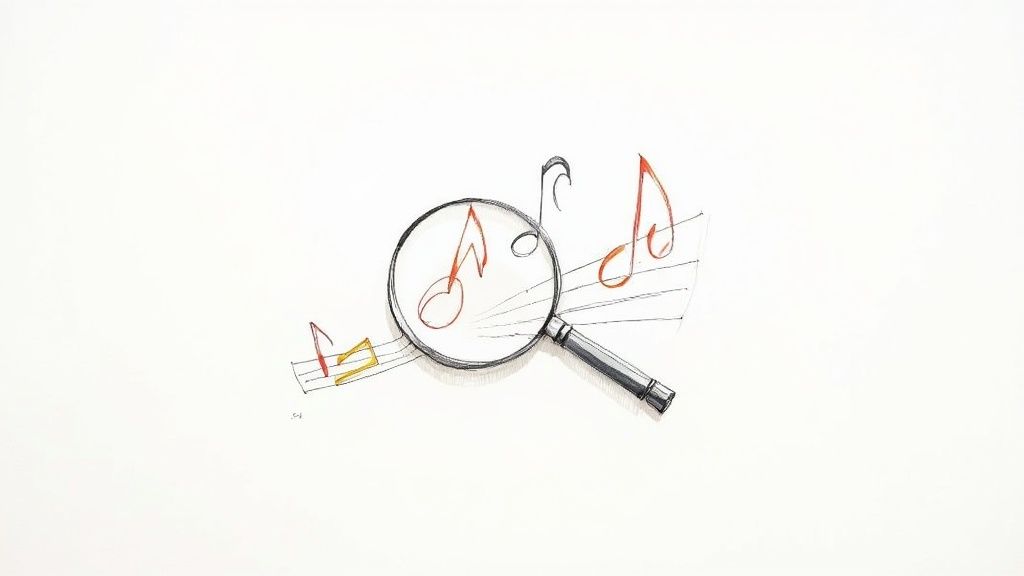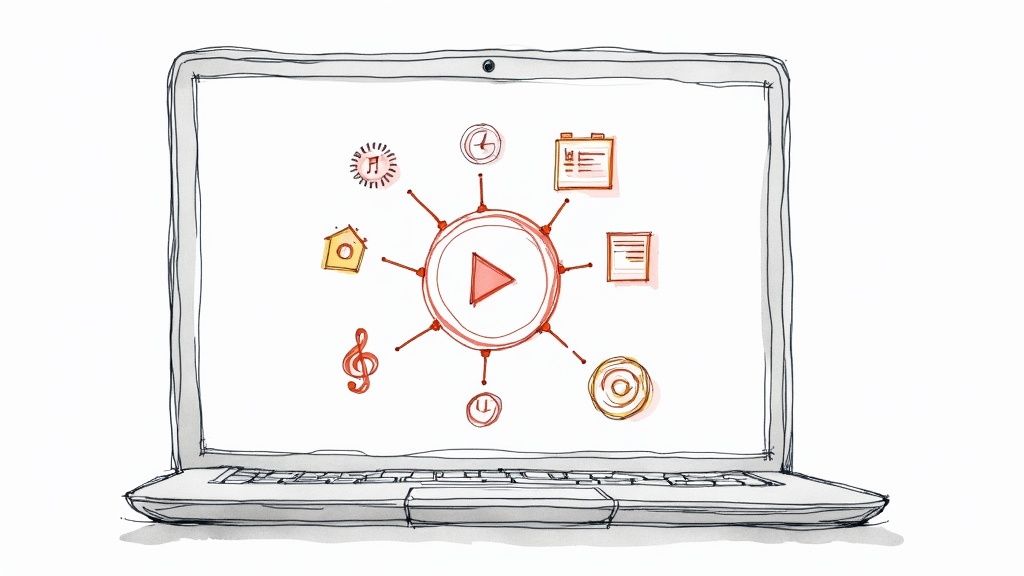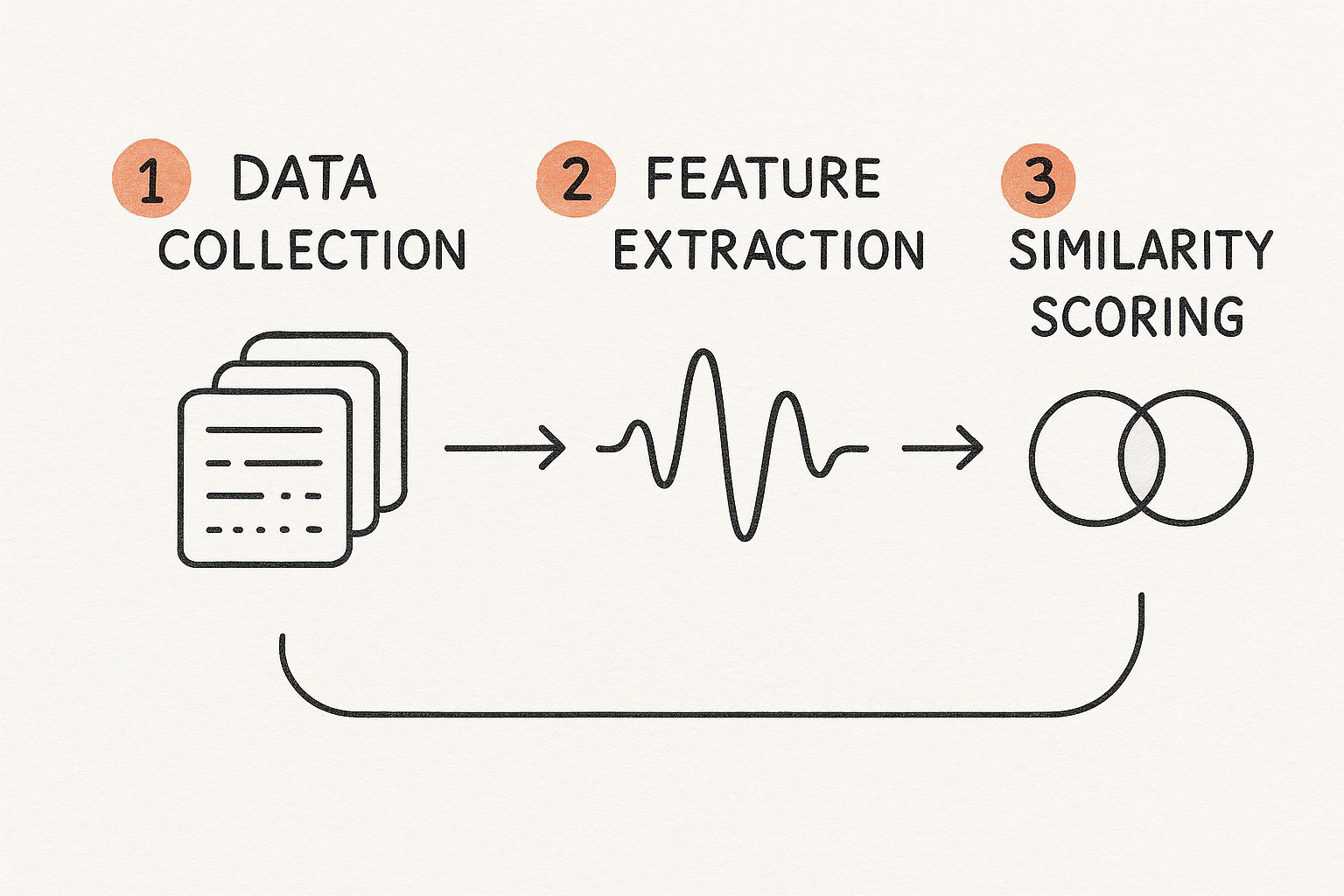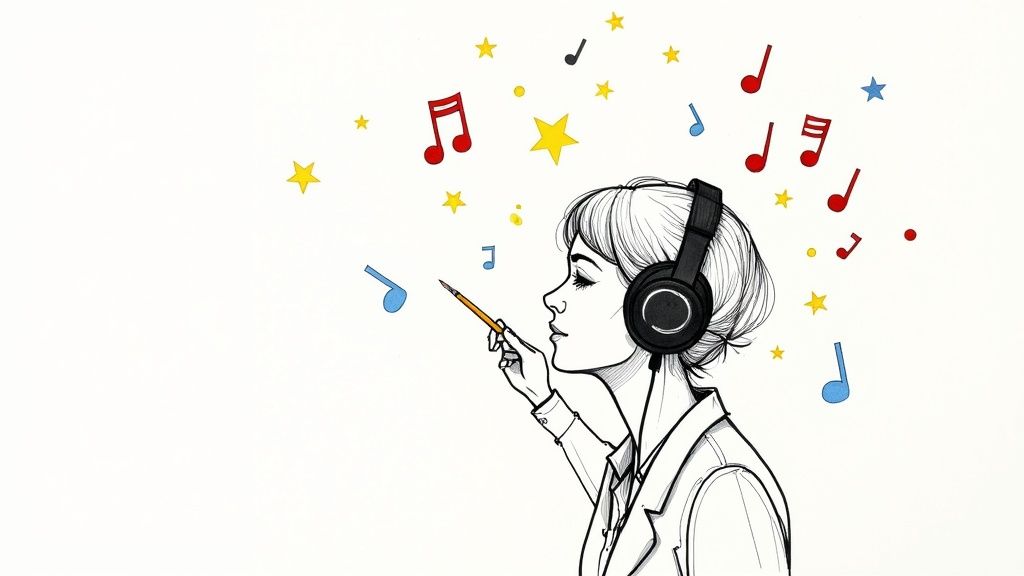Find Similar Artists and Grow Your Fanbase
- Giuseppe Maria Bità
- Oct 4
- 11 min read
So, where do you even start when trying to find similar artists? A great first move is to look at Spotify's "Fans Also Like" section and dig into the public playlists your music is already on. This gives you a quick snapshot of your sonic neighborhood, showing you which artists share your core audience and general vibe. Think of it as mapping out your musical ecosystem before you dive any deeper.
Why Finding Similar artists is Your Growth Blueprint

Figuring out who you sound like isn’t just a fun exercise—it’s the absolute bedrock of a smart growth strategy for any modern musician. When you know how to find similar artists effectively, you’re basically creating a blueprint for targeted, efficient promotion. This isn't optional stuff; it’s essential for building a real career.
This knowledge directly fuels several key marketing moves:
Effective Playlist Pitching: Curators need context. Telling them, "My music will connect with fans of Artist X," gives them an instant reference point. This dramatically boosts your chances of actually getting placed.
Targeted Ad Campaigns: Stop wasting money advertising to people who will never listen to your music. Instead, you can build campaigns that zero in on listeners of specific artists who already love your style of music.
Uncovering Collaborations: Identifying artists in your circle opens up a world of possibilities for features, remixes, and co-promotions that let you cross-pollinate fanbases.
Define Your Niche and Audience
Identifying your musical peers helps you really lock in your specific niche and get a clear picture of what your ideal fans are already listening to.
For instance, an indie-pop artist I know discovered her fans were also heavily listening to a couple of lo-fi R&B acts. This was a lightbulb moment. It led her to start pitching her music to lo-fi playlists—a genre she hadn't even considered before.
Key Takeaway: This research isn’t just about finding artists who sound exactly like you. It's about finding artists who share your audience, which is a subtle but incredibly important distinction for growth.
This strategic shift landed her on several influential playlists, and her monthly listeners shot up by 40% in just two months.
The way we discover music has been completely reshaped by streaming platforms. As of 2025, over 85% of recorded music revenue flows from services like Spotify, which rely on recommendation engines to connect listeners with new artists. You can dig more into the state of the music industry on 1stdropmusic.com. This reality makes your ability to find and understand your similar artists more crucial than ever before.
Unlocking Spotify's Native Discovery Tools

We've all seen this section. It's the most obvious place to start, but honestly, it’s just scratching the surface. To really find artists that can move the needle for your career, you have to dig deeper into the platform itself.
Spotify is an incredibly powerful research tool, but most artists stop at the first layer. The key is to start thinking like the algorithm. Every time a listener saves your song or adds it to a playlist, they're leaving a trail of data. Your job is to follow that trail and see where it leads.
Moving beyond the familiar "Fans Also Like" section is your first real step toward building a reliable list of peers for your campaigns.
Go Beyond the Obvious Artist Profile
"Fans Also Like" is a decent gut check, but it's often a lagging indicator. It's built on broad, long-term listening habits, not the immediate, real-time connections that show where your music is resonating right now. For that, you need to look at the features that reflect active listening patterns.
Here are a few powerful, and often overlooked, ways to do just that:
Dig Into Public Playlist Adds: Where are real listeners organically placing your songs? Go on a hunt for public playlists that feature your music. If your track consistently shows up next to artists like Glass Animals and Tame Impala, that’s a massive signal from your audience about who they see as your contemporaries.
Use the "Go to Song Radio" Feature: This is your direct line to the algorithm. It's like asking Spotify, "Hey, who do you think I sound like?" Start a radio station from one of your own tracks and pay close attention to the first 10-15 songs that pop up. That list is Spotify telling you exactly where your song fits in its sonic universe.
Explore Artist Radio: This gives you a slightly broader view. Firing up a radio station based on your own artist profile shows which artists the algorithm thinks share your overall vibe and target audience. It's perfect for building out that initial, foundational list.
For a much deeper dive into getting the most out of the platform, check out our full guide on the essential tools within Spotify for Artists.
Pro Tip: This isn't a one-and-done task. You should run these radio experiments every so often, especially right after a new release. The algorithm is constantly learning, and the artists it connects you with can change as your sound evolves and your audience grows.
Comparing Spotify's Discovery Features
To help you decide which tool to use and when, here's a quick breakdown of what each one offers. They all provide a piece of the puzzle, but they're not interchangeable.
Spotify Discovery Feature Comparison
Feature | What It Tells You | Best For |
|---|---|---|
Fans Also Like | Broad, long-term listener affinity. | Getting a quick, high-level overview of your general musical neighborhood. |
Song Radio | Direct sonic and mood-based comparisons for a specific track. | Finding artists with a very similar sound for targeting specific playlists or ads. |
Artist Radio | Broader audience and vibe comparisons for your entire catalog. | Identifying artists who share your core fanbase for tour or collaboration ideas. |
Public Playlists | How real listeners are curating and categorizing your music. | Uncovering unexpected artist connections and understanding fan perception. |
Think of these tools as a progression. "Fans Also Like" gives you the general direction, but Radio and Public Playlists are where you'll find the specific, actionable names for your list.
Interpret the Data and Build Your List
Right now, your only job is to gather names. The goal is to build a master list of at least 20-30 potential artists. Don't filter or judge anything yet; just collect every name that keeps showing up across these different Spotify features.
Think of yourself as a detective gathering clues. A single mention might be nothing. But when an artist's name appears on a fan playlist, in your song radio, and in your artist radio? You've just found a seriously strong lead. This raw list is the bedrock for the deeper analysis you'll do later.
Go Deeper with Third-Party Tools
Spotify's own features like "Fans Also Like" are a decent first step, but they really only scratch the surface. If you're serious about building a smart outreach strategy, you need to go deeper. This is where dedicated third-party tools come into play, helping you turn a rough list of potential peers into a curated, data-backed roadmap.
Platforms like artist.tools are built for this. Think of it like switching from a flashlight to a floodlight. Instead of just seeing who sounds similar, you can pull back the curtain on an artist's entire Spotify ecosystem. You get access to their playlist reach, historical monthly listener data, and follower growth—all the metrics you need to confirm if they're a genuine match for your goals.
The general process these tools follow is pretty sophisticated. They collect mountains of raw data, extract the most important features, and then calculate a similarity score. It’s how they translate all that noise into a clear signal for you.

This workflow is what allows you to move beyond gut feelings and pinpoint artists who are truly comparable based on concrete numbers.
Validate Your List (And Avoid Wasting Time)
Data is your best friend for cutting through the noise and dodging dead ends.
Let's say you find an artist on your Spotify Radio who seems like a perfect sonic fit. But a quick data check reveals their monthly listeners are massively inflated by a single viral TikTok moment from two years ago, with zero sustained growth since. That’s not a reliable peer for your current campaign.
On the flip side, you might uncover a smaller artist who has a highly engaged audience and is steadily climbing the ranks on key tastemaker playlists. Now that is a valuable connection worth pursuing.
Here are a few key indicators I always look for to validate a match:
Consistent Monthly Listeners: Are their numbers stable or climbing? Or are they just coasting on fumes from a single past hit?
A Healthy Playlist Ecosystem: Are they getting love across a good mix of editorial, algorithmic, and big user-generated playlists? A diverse portfolio is a great sign.
Shared Audience Demographics: Check their top listener cities. Do they overlap with yours? This is a huge clue that you share a similar fanbase.
By cross-referencing your initial hunches with hard data, you build a list based not just on musical vibe, but on shared audience behavior and career trajectory. This is the bedrock of any outreach campaign that actually gets results.
For a more detailed breakdown, our **guide to Spotify playlist analyzer tools for artists** really gets into the weeds of evaluating playlists and the artists on them. This extra layer of analysis ensures you’re not just finding similar artists, but finding the right similar artists who can genuinely help you grow.
Turning Your Research Into an Actionable Strategy

So you've got a long list of artists. That's a great start, but it's really just raw data. The real magic happens when you organize this information into a concrete marketing plan. This is where you transform your research from a simple spreadsheet into a powerful roadmap for your music career.
The most effective way to do this is by sorting your list into distinct tiers. This isn't about ranking who is "better." It’s about understanding their strategic value to you right now. When you organize your efforts this way, you make sure you’re pitching the right people with the right message.
Create Your Artist Tiers
Let's break it down. Segment your list into three practical categories. This simple approach will define how you connect with each artist and what you hope to get out of it.
Aspiration Artists: These are the heavy hitters—the ones with huge, established followings. You’re probably not going to collaborate with them tomorrow, but they are your North Star. Study them to understand the playlists, media outlets, and brand partnerships that define success in your niche.
Peer Artists: These are the musicians at a similar stage in their career. Think comparable monthly listeners and follower counts. They are your prime targets for collaborations, tour swaps, and genuine networking.
Emerging Artists: These are the up-and-comers who are buzzing but haven't quite broken through yet. Building relationships here can lead to powerful cross-promotions as you grow together.
This tiered system is your action plan. It tells you who to study, who to connect with, and who to collaborate with, turning a vague goal to find similar artists into a focused outreach strategy.
This method actually mirrors how the wider industry operates. A&R professionals increasingly use data to find artists who resonate with diverse audiences, often blending genres to create unique sounds. This strategy integrates listener behavior and social metrics to discover talent at scale. You can read more about these music industry predictions to see just how much data is shaping discovery.
By creating your own tiered system, you are essentially adopting a professional A&R mindset for your own career. It ensures every outreach effort is targeted and effective.
Finding Artists on TikTok and Social Platforms
Let's be real: music discovery isn't just happening on Spotify anymore. To find artists who truly share your vibe, you have to look where culture is bubbling up in real-time—and right now, that's TikTok, Instagram Reels, and YouTube Shorts. These aren't just social apps; they're essential research tools for any serious artist.
By watching the trends on these platforms, you get a direct line into what’s actually connecting with listeners in your specific niche. It's not about chasing the biggest viral dance challenge. It's about spotting the micro-trends. If artists similar to you are getting traction with stripped-down acoustic clips on Reels, that's a massive clue for your next piece of content.
This shift has basically created a new lane: 'social music streaming.' It's this blend of social media interaction and pure music discovery. For younger listeners especially, finding new tracks through a 15-second video is way more common than just browsing a streaming app. If you want to dive deeper, you can explore more music streaming trends on dataart.com to get a handle on this new reality.
Turning Social Insights Into Action
Okay, so watching trends is one thing, but actually doing something with that information is what separates the pros from the hobbyists. Your goal here is to spot the patterns and let them shape your own content strategy. It's a fundamental part of building a career today.
Here’s a practical way to break it down:
Hunt for Trending Sounds: Keep a running list of the sounds and songs that pop up again and again in your corner of the internet. Who are the artists behind them? Get them on your radar.
Analyze the Formats: Pay close attention to the type of video that's performing well. Are people responding to live performance snippets? Behind-the-scenes studio moments? Or videos that jump on a specific trend?
Look Beyond the Obvious: Music discovery is happening in some unexpected places. Think about popular Twitch streamers or the in-game radio stations in massive games. Which artists are getting featured there? If their sound aligns with yours, that’s another vein to tap.
By actively monitoring these platforms, you're not just finding artists—you're uncovering a content playbook tailored to your audience. This social listening is as crucial as analyzing playlist data.
Having a strong social media game is completely non-negotiable for musicians in this day and age. For a deeper dive into building your presence, check out our guide to social media marketing for musicians. This is how you make sure your music gets seen and heard where your future fans are already hanging out.
Putting It All Together: Your Outreach Plan
So you've done the digging and have your tiered lists of similar artists ready to go. That's the hard part done, right? Almost. All that incredible data is just a collection of names until you actually do something with it. Now it's time to turn that research into real-world connections that can genuinely push your music career forward.
The goal here isn't to blast out a hundred generic emails and hope for the best. It's about crafting smart, personalized messages that show you've done your homework. A well-researched pitch feels less like a cold email and more like a genuine invitation to connect—and that's what gets you a response.
Crafting Your Pitches
Your outreach strategy needs to be as carefully tiered as your artist lists. You wouldn't hit up an 'Aspiration' artist with the same casual DM you'd send to a 'Peer,' and your pitch to a playlist curator needs a completely different angle.
For Playlist Curators: Get straight to the point and give them context. Reference the peer artists you found on their playlists. A simple, "Hey, I saw you featured Artist X and Artist Y, and my new track has a similar atmospheric vibe," immediately tells them you understand their taste and that your song is a good fit.
For Peer Artists: This is about finding a win-win. Keep it authentic and propose something that benefits you both. Think about a feature swap, a joint Instagram Live, or even just co-promoting each other’s new releases to your audiences.
For Social Media Ads: Here's where your 'Peer' and 'Aspiration' lists become your secret weapon. Use them to build hyper-targeted ad campaigns on platforms like Meta. You can create custom audiences based on interest in those specific musicians, meaning your ads land in front of people who are already primed to love your sound.
Tailoring your outreach is what separates the pros from the amateurs. It shows respect for their time and proves you're not just another artist spamming their inbox. This is how a simple spreadsheet transforms into a powerful networking tool.
Remember, that first email or DM is just the beginning. The real magic happens when you start building genuine relationships with curators and other artists. This is a long game, and the payoff—becoming a respected member of your music community—is worth far more than a single playlist add.
Ready to turn all this research into a real advantage? With artist.tools, you can validate your similar artist lists, find contact info for curators, and track your growth with precision. Start making smarter, data-driven moves for your music career at https://artist.tools.
Comments